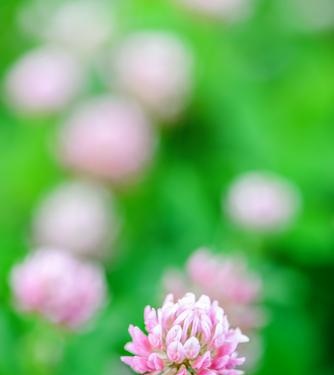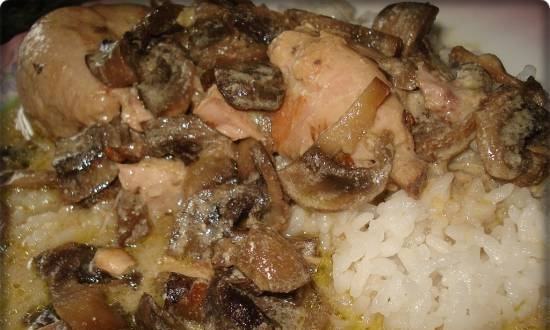|
 At the beginning of the last century, even before the invasion of Napoleon, there was a lot of talk in Russia about the eccentricities of the Tula landowner A. Roznatovsky. Having a lot of good hayfields, he began to sow woodpecker grass for cattle fodder. At the beginning of the last century, even before the invasion of Napoleon, there was a lot of talk in Russia about the eccentricities of the Tula landowner A. Roznatovsky. Having a lot of good hayfields, he began to sow woodpecker grass for cattle fodder.
The food for the cattle turned out to be so tempting that the entire four-legged population from the Roznatovsky estate rushed to the plantations. The neighbors' horses came running in herds, ate out under the root, knocked out with their hooves so that they had to sow again.
I had to urgently fence off the experimental site. The fences didn't help. Then they dug a deep ditch around the entire plot of 28 acres, and nearby they poured a rampart of such a height that the horses could not jump over. The rampart was reinforced with sod, and in this form the engineering structure has survived to this day.
Dyatlovina in those years was called red clover. Tall, bushy, with trifoliate leaves and red pompoms of inflorescences. Seeds were obtained from abroad, although their red clover, wild, grew nearby in the meadows. It was believed that foreign is more profitable.
They mow their own once a summer, imported - two. One by one the landlords joined the clover boom. First out of curiosity, like Roznatovsky, then out of profit.
However, the first enthusiasm was soon replaced by disappointment. The foreign woodpecker - Dutch or German - turned out to be unstable. It did not grow long, the thickets were decrepit, thinned out. The meadow was turning into a wasteland. From abroad they suggested that the soil was probably not the right one. You need a dense, clayey: if you hit with a boot, the heel will fly off! They beat me with heels, how many boots they ruined, and the clover did not work out properly. Finally they found out: it was not the soil, but the climate. Clover dies due to cold weather. Freezes over. Western Europe is warmer than Tula. And even with two mows, the Tula clovers did not give a large increase. Rather the opposite. In the end, clover was condemned as unsuitable for Russia.

And only the peasants of the Yaroslavl village of Konishchevo in 16 yards with fanatical persistence continued to sow woodpecker for a hundred years in a row. From generation to generation. During this time, the clover has changed. From two-mowing to one-mowing. And it seems to have become less chilly.
So it seems clear: cultivated clover came from foreign varieties. But who can guarantee that history has accurately recorded a century-long journey of forage grass? Who can prove that modern clover is not a descendant of the local wild race? Stronger evidence is needed.
The famous meadow scientist Professor P. Lisitsyn undertook to find them. He grabbed onto two metrics: protein-protein and ash. According to the content of both clovers differ. The cultured protein reserve rises to the south. The local, wild - to the north. If the cultural originated from the local, then its protein would decrease to the south and increase to the north. In terms of ash supply, wild clover from different places is the same. Cultural - no. To the south, the ash in the stems becomes more, to the north - less. It was then that it was finally confirmed: our cultured red clover is a descendant of a foreign one. That is why he is so gentle and unstable. And breeders would be better off introducing their own, homegrown into the culture.
And in general, you can't get away with clover. Take at least the seeds. You can write a whole detective novel about clover seeds. There was always a lack of them. And to get a profit, seed firms mixed small pebbles into their products, which were dyed in advance to match the color of clover seeds. The landlords bought, sowed colored pebbles and then wondered why such rare seedlings.
When they found out, they began to sow their own homegrown seeds. But here it didn’t work either. Even the wisest agronomist of Russia I. Klingen at the turn of the century could not get them in abundance. Every year fewer and fewer seeds were born. In other years, nothing was collected at all. One grass turned green. Klingen found out the reason: disturbances in agriculture.In those years, more and more land was plowed, all the earlier mowed meadows. Clover pollinators were driven out of their domain. The only refuge for the unfortunate bumblebees were strips along the railways and ravines (and ravines can be useful).

It was necessary to urgently look for substitutes for bumblebees. In 1900, such a substitute was found - the common bee. Beekeeper A. Titov put his bees on the clover, and each family brought him a bucket of honey over the summer. However, there were few such happy years. More often than not, bees did not work on clover. We flew anywhere: to buckwheat, to linden, to raspberries. Not the clover. Cause? Unsuccessful flower design. The whisk tube is too long. She is like a deep well. The bumblebee has enough proboscis to reach the bottom, the nectar. And the bee is missing. It happens that the year is dry. The tube will not grow to its normal length. Will remain scanty, shortened. Then the bee will reach. Or vice versa, a very solid year when the flowers are overflowing with nectar. But these are exceptions.
Klingen decided to do without the services of a regular bee. For pollination of clover, in 1908 he ordered gray, Caucasian ones from Abkhazia. Those have a longer proboscis and just fit to reach the nectar. In the first year, the Caucasian bees processed the clover so carefully that the harvest of seeds was four times greater than with bumblebees. Encouraged by his luck, Klingen began to write bees more and more from the Caucasus. Three years later, he had already accumulated about a thousand bee colonies.
It was possible, of course, to do with ordinary bees, but then you have to work with clover for many years and select varieties where the corolla tube is shorter. Or to breed a bee with a long proboscis. Observing the accuracy, I note that the gray Caucasian bee is good, but it mixes very quickly with the ordinary, Central Russian. And the descendants lose the most important quality - a long proboscis. In addition, it winters poorly in the north.
In general, the surest way is to breed a normal bee with a longer proboscis. In the meantime, this is not done, they force the short-haired to work on clover. Contrary to their wishes. Beekeepers have to resort to deception. When clover blooms, bees fly by, to other crops that bloom at the same time. Klingen noticed this and mowed everything except clover. Thus, he wanted to force the winged workers to go to work with the help of hunger. The bees were starving, but they did not go to clover.
Now they are trying to do the opposite: preserve other honey plants and maintain the strength of the bee colony. And in order to seduce the stubborn and attract them to the clover, they dilute sugar syrup, soak bouquets of clover in it and sprinkle the infusion over the clover. Of course, the deceived creatures rush after the sugar rain. And having got used to the clover smell, then they fly for the usual nectar.
It would seem that success has been achieved? The bees resisted and got down to work. They are buzzing on the clover, carrying honey to the apiary. Along the way, they perform the main task - pollinate flowers. This is what guarantees the harvest. But when the beekeepers weighed the profit in the hives, they were upset. They know that each hectare of cloverland produces 260 kilograms of nectar. And the hives got only ... 6! Where is the rest? Remained in the whisk tubes. The proboscis is short!

But maybe the seeds are safe? No, and here the success is only partial. The behavior of bees on clover is still not fully understood.
They do not sit on every inflorescence. More often the bee will circle, buzz and fly away without landing. Passes one head, another, third. Finally liked it. Sits down. Pollinated one flower. One more. And further. The rest did not like something (and there are several dozen!). She snorted and flew away - to choose tastier or more comfortable. Maybe looking with a shorter whisk or a full-bodied portion of nectar?
So, hope for a bee, but don't make a mistake yourself. Willy-nilly, you have to remember about bumblebees. It is not for nothing that bumblebees are being guarded near Kalinin. Where their nests are, even livestock is forbidden to graze, despite the best grass. After all, these workers do their job without flaws and in any weather!
The complete opposite of red clover is white. This one supplies nectar to everyone who needs it and who does not need it. The nectar in the flowers is shallow. Get all and sundry. In a good year, bees collect three buckets of honey per hectare. In the bad - zero. In front of other honey plants, white clover is far ahead. Nectar also accumulates in drought. The most important property is that he is not afraid of trampling. Though squat, but tenacious. The more it is trampled on, the more it grows (up to certain limits). Cause? Shoots are trampled into the ground and take root. Only in height it does not grow very much. It spreads along the ground, for which it is called creeping. Wherever it is not! And near Moscow, and in Siberia and in New Zealand.
Agronomists have always dreamed of a taller white. Well, at least like red. And fate took pity on them. In Italy, Russian travelers found one near the city of Lodi. Oh joy! Immediately brought home. Sowed in Ukraine. The heat-loving giant froze out. Vinnitsa craftsmen selected those plants that survived and developed a new variety - Giant White. Near Vinnitsa Gigant winters well. Artyukov learned about it and sowed it in the Urals. Vinnytsia Giant died out. There are only a few bushes left in the garden.
But maybe you can find your White Giant in the Urals. The discovery of botanist M. Popov at Lake Baikal convinces that among their own home-grown clovers there are outstanding masterpieces. The world famous botanist M. Popov, a corresponding member of the Academy of Sciences, came to work on Lake Baikal after the war. There he learned that cultural clovers are freezing out. Not even Italian or Vinnytsia, but Central Russian, which the settlers from Tver and Smolensk brought with them. Winter in the Baikal region has little snow, that's the point.
There is a very good wild type of clover in Siberia - lupine clover. Beautiful: redhead head, leaves are not the usual triad, but graceful fives, like lupine. And most importantly, it does not freeze. The cattle eats it with great pleasure. One problem is that there are not enough leaves. One edible head and a stalk. In addition, due to the small foliage in the meadows, weeds clog it.
Once Popov went on a tour with student L. Bardunov along the banks of the Sarma River. The place is notorious for the hurricane wind of the same name. It suddenly collapses from the mountains, drowns the boats in Lake Baikal and smashes them into pieces on the rocky shores of Olkhon Island. Exploring the banks of the river, Popov noticed the crimson heads of that same lupine clover, but he did not look quite ordinary. It did not stretch up with thin stalks, but fell apart to the sides with many lush shoots. Its curtains thickened, merged with each other. This only helped the red-headed clover, because now it easily fought off the neighboring plants.

Popov immediately realized that this was exactly the kind of clover that agronomists had dreamed of for decades. Moreover, its own, Siberian, adapted to little snow and not drowned out by herbs. In January 1954, the scientist had already reported in Irkutsk at a meeting of livestock breeders about his find.
And now I would like to tell one old parable about clover, which is most directly related to its fate today. The parable tells about the important role sometimes in the life of clovers ... cats play. This legume herb is known to be pollinated by bumblebees. The more bumblebees, the better for clover. But bumblebees are destroyed by mice. The more mice, the worse for bumblebees. So much the worse for clover. However, mice are controlled by cats. The more cats, the fewer mice. The fewer mice, the more bumblebees. The better the clover is pollinated.
This parable could be taken for a reality, if not for one circumstance. Cats live in houses and usually do not roam the clover. However, there is one beast that replaces the cat. A fox! It was she who always controlled the mice in the fields and, where clover was sown, protected him.
But the situation has changed. This is what I read in one of the central newspapers in Ukraine. It said: there are fewer foxes. In Ukraine, their number has almost halved in recent years. This was reflected in the clover along the chain of links.In 1948, there were so many mice that they eliminated all clover crops in the Vinnytsia region and in the neighborhood. Experts fear that the fox in Ukraine may soon disappear as a species and then the history of 1948 may repeat itself. In the meantime, a lot of money has to be spent on fighting mice. The fox could return this money to the state piggy bank.
A. Smirnov. Tops and roots
|
 At the beginning of the last century, even before the invasion of Napoleon, there was a lot of talk in Russia about the eccentricities of the Tula landowner A. Roznatovsky. Having a lot of good hayfields, he began to sow woodpecker grass for cattle fodder.
At the beginning of the last century, even before the invasion of Napoleon, there was a lot of talk in Russia about the eccentricities of the Tula landowner A. Roznatovsky. Having a lot of good hayfields, he began to sow woodpecker grass for cattle fodder.













